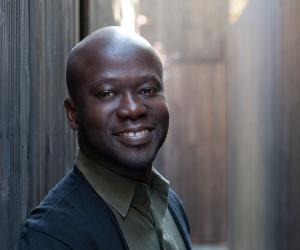Gwangju is best known for the Gwangju Massacre on 18 May 1980, in which 200 students were killed by army forces supressing a pro-democracy demonstration in South Korea. Today renowned architect David Adjaye in collaboration with author Taiye Selasi realised this striking pavilion in memory of the students and their fight for freedom.
The Gwangju pavilion, “The River Reading Room”, situated on the banks of the Gwangju River, forms the final stepping stone connecting the street level above with the grassy flood planes used as a seasonal park. The memorial takes its inspiration from a reading room where people are encourage to relax and reflect, further more encouraging interaction between the city’s inhabitants and learning through books.
With 200 books separately slotted into the walls and pillars of “The Reading Room”, Adjaye encourages Gwangju citizens to never forger the 200 students who lost their lives.
The pavilion constructed from off-shutter concrete and timber drawing on the vernacular of Korean pavilions and houses. The concrete base is designed so that it can be submerged under the water at high tide, making the timber columns seem as though they are floating on top of the water’s edge.
Visitors are encouraged to use the pavilion in different ways, ensuring the structure is constantly changing and reflecting the condition of its surroundings.
The Gwangju River Reading Room is part of the Gwangju Folly project, initiated by the 2011 Gwangju Design Biennale under the direction of Seung Hyo-sang and Ai Weiwei, which evolved into an independent program, and is set to showcase a series of new follies in the urban space of Gwangju. Gwangju follies contribute to urban regeneration in the city, playing both decorative and functional roles in public spaces. Eight follies have been realised so far.









